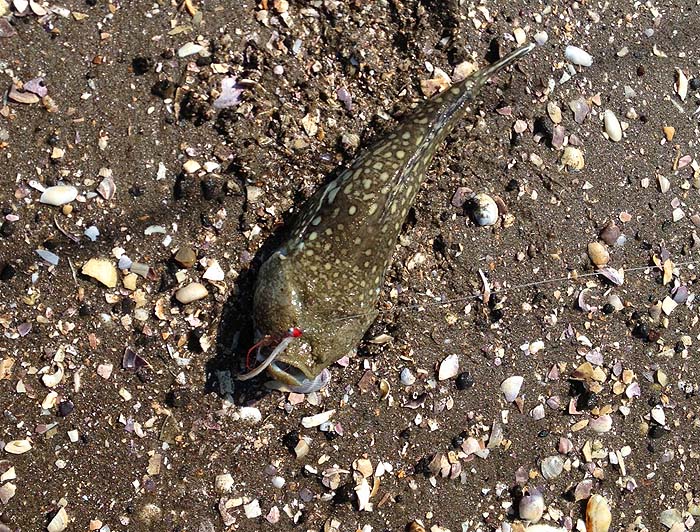 '
'Information Page.
Monkfish!
My New Zealand pal Alan has really taken to saltwater fly fishing. He has always been a good trout angler but these days he often fishes from his local beaches and, needless to say, there's a fair chance that it will turn up something unusual -
Hi Mike,
Just got back from a couple of hours fly fishing at Tahuna Torea. Low tide was 2.00 pm which was far from ideal. The day was absolutely glorious. Sunny, azure skies with lackadaisical daubs of cloud and a gentle 10 kilometre an hour zephyr from the West to aid casting.
I strolled out across the crushed shell foreshore bumping into a steady eclectic mixture of walkers, joggers, families with children and the odd photographer. Each, in their own way, enjoying the warmth of the sun on pale UV starved skin. By the time that I reached the end of sand spit after a solid 20 – 25 minute walk I was beginning to regret wearing thigh waders and a camouflage raincoat. Once I started fishing however, I quickly cooled down as the steady breeze set to work.
The outgoing tide was pushing against a submerged sandbar near #5 buoy and this was causing dislodged sediment to well upwards creating an area of “dirty” water that was clearly delineated from the surrounding mass. I attached a bronze Clouser and starting casting slightly upstream but parallel to the 'crease'. By the time the fly sank it was well into the dirty water and second cast the fly got monstered by a small kahawai (15”). It danced around the shallows for a few minutes and pulled some string before giving itself up just as a ferry sailed past. Two passing lycra clad joggers (unfortunately male) stopped to watch the fight and bombarded me with questions as I gently released the fish.
Buoyed by this I set to work in earnest, whipping the water to a foam for the next hour without reward. By now the tide flow was starting to slacken appreciably and I was beginning to feel that nothing else was going to happen. Then, almost on cue, the line tightened. I strip struck and came up solid on a weight which wriggled. I thought at first that I’d just snagged a big starfish or a weed encrusted rock as it seemed to be twisting when drew it closer. Imagine my surprise when a small 15” monkfish hove into view (see attached). A first on a the fly.
I persevered for another 45 minutes or so, changing flies twice, but nothing was doing as the tide movement ceased. There was a steady procession of trailer boats racing past and several large ferries. No problems dealing with the wakes in thigh waders! The endless noise cannot have helped my chances.
I’m picking that Tahuna Torea fishes best between mid-outgoing tide and about 45 minutes before dead low when there is a steady current washing hard against the submerged sand bar. Will have to try again next weekend.
Tight lines and best wishes,
Alan Bulmer
Interesting! Now common names of fish are always a bit of a problem, our 'monkfish' is something quite different. I could see, from the picture, that the fish was some sort of scorpion fish or stargazer and I know that some of these have poisonous, even deadly, spines. Anyway, I asked Alan about this and it turns out that the one he caught is a giant stargazer (they grow large) but it is not poisonous. The fish is highly regarded as a culinary delicacy because the flesh is very firm and sweet. He says the urban legend is that monkish fillet is often cut into circles and passed off as scallop (sans roe).
If you have any comments or questions about fish, methods, tactics or 'what have you.'get in touch with me by sending an E-MAIL to - docladle@hotmail.com'Monkfish', stargazer.
 '
'